Why you can trust Tom's Hardware
The Asus TUF Gaming VG289Q is exceptionally good out of the box. Calibration is unnecessary, but if you choose to calibrate, some small gains are possible (see our recommended settings).
Grayscale and Gamma Tracking
We describe our grayscale and gamma tests in detail here.

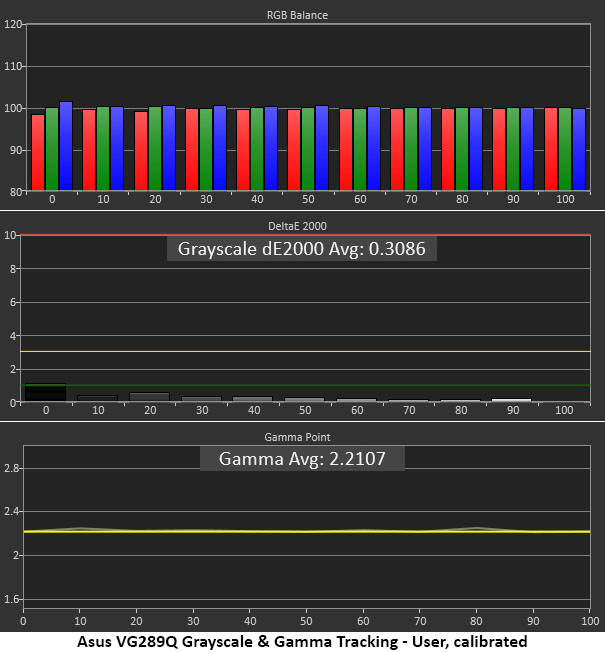

There are no visible grayscale errors in the VG289Q’s default Racing mode. The i1 Pro meter noted a tiny rise in green as brightness increased, but you can’t see this with the naked eye. Gamma also tracked perfectly with no visible aberration. This is an especially good thing because there are no gamma presets available in the OSD. The lack of gamma preset isn’t a big deal, but we’d like to see choices if one wants a darker or lighter presentation.
Switching to User mode allows adjustment of the RGB sliders. Though the gain in accuracy wasn’t visible to the eye, it’s easy to see in the second chart above. Check out the middle Delta E (dE) graph; errors are almost non-existent. Gamma was unchanged as well. It truly doesn’t get better than this.
Asus includes an sRGB mode (third chart above) in the presets, and it locked out all other image controls. Its errors are minimal and will be hard to spot. An average error of 1.91dE is excellent for an unadjusted monitor. Our meter found a slight rise in red, but gamma was just as true as with the other picture modes.
Comparisons
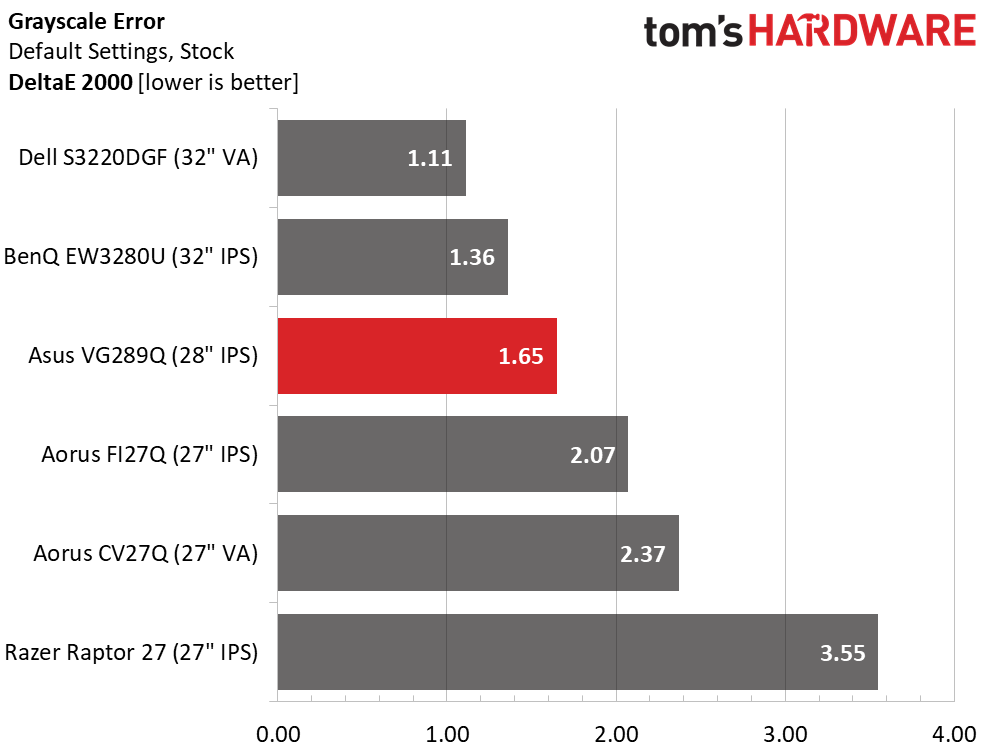
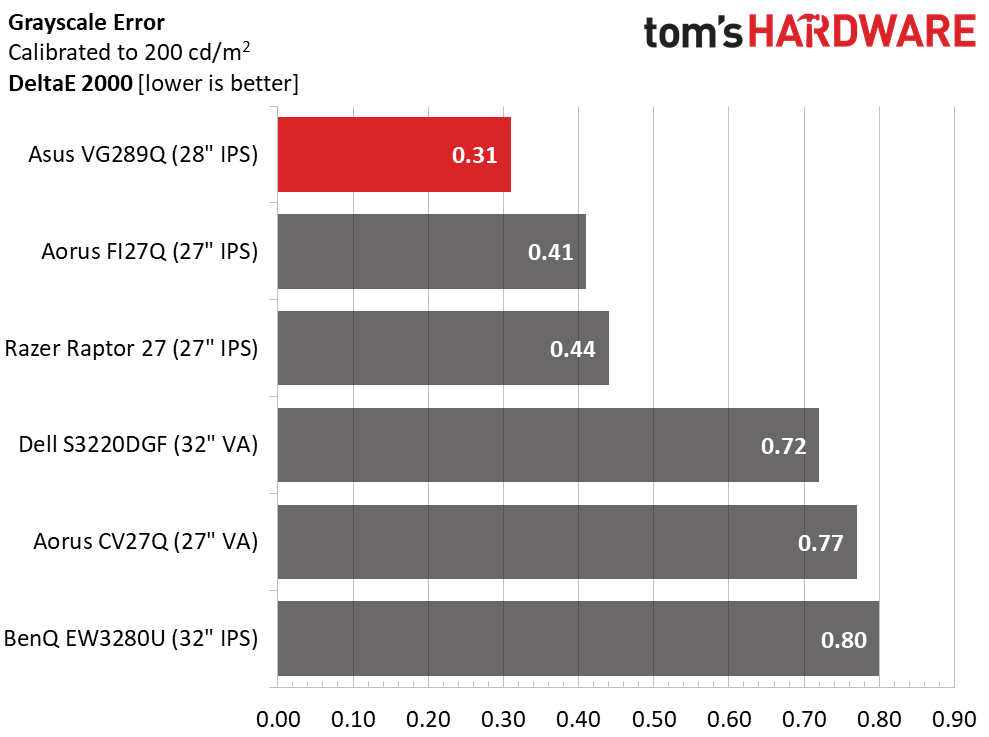

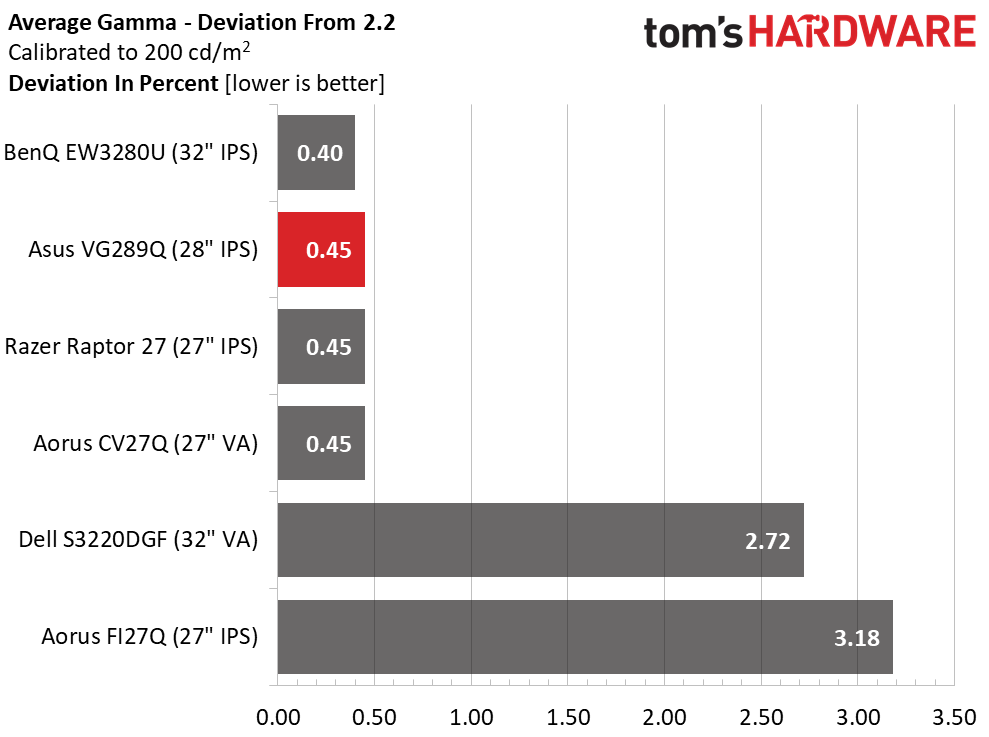
The VG289Q’s Racing mode has a very low grayscale error of 1.65dE out of the box. Therefore, calibration is only necessary if you want the absolute lowest possible numbers. Visually, there was no need for it, as 0.31dE is one of the lowest grayscale tracking scores we’ve recorded. In any case, after calibration (see our recommended settings) we hit professional monitor territory – from a display that costs less than $400.
Gamma was no less impressive with a tiny 0.04 range of values and an average of 2.21. This all bodes well for the color gamut test coming up next.
Get Tom's Hardware's best news and in-depth reviews, straight to your inbox.
Color Gamut Accuracy
The Asus TUF Gaming VG289Q is a DCI-P3 monitor. It uses an expanded color gamut for all content, both SDR and HDR. Though there is an sRGB mode in the OSD, it does not reduce color saturation enough to match that standard.
For details on our color gamut testing and volume calculations, click here.
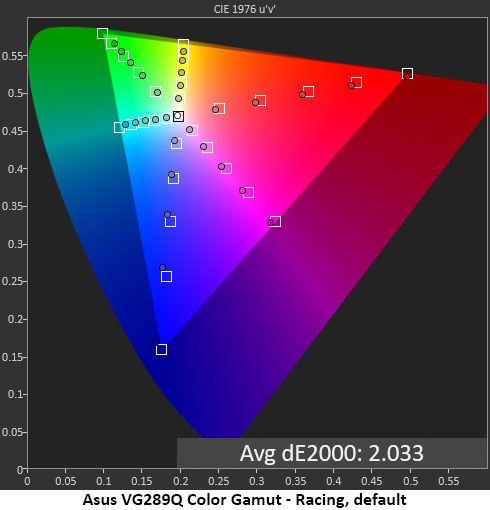
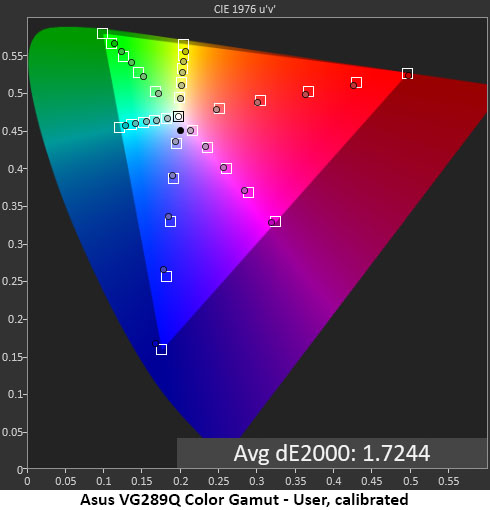

Out of the box, the TUF Gaming VG289Q hit enough of the DCI-P3 targets to post a low error of just 2.033dE. Red, blue, magenta and cyan are within 2dE of the mark, while green and yellow were under-saturated by 10-20%. This didn’t dramatically hurt HDR image quality, but some elements, like grass and sunlight, didn’t have quite as much punch. In other words, such elements didn’t look much different in HDR than if they were rendered in SDR and the sRGB color space.
Calibration lowered the average error a little (second chart), but the image looked the same in our eyes. This was achieved solely with adjustment of the RGB sliders; there was no need to change the color saturation control.
The monitor’s sRGB mode (third chart) did little to shrink the color gamut. When compared to that standard, red was nearly 20% over-saturated at all points. Other colors were only slightly over, which contributed to a low average error level.
Comparisons
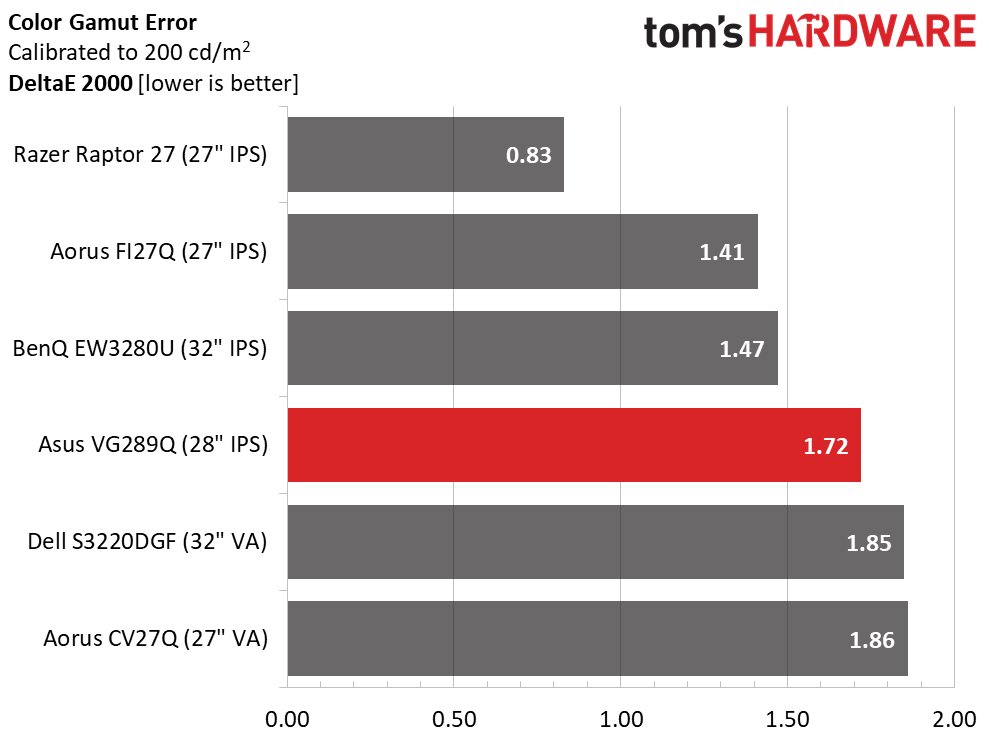
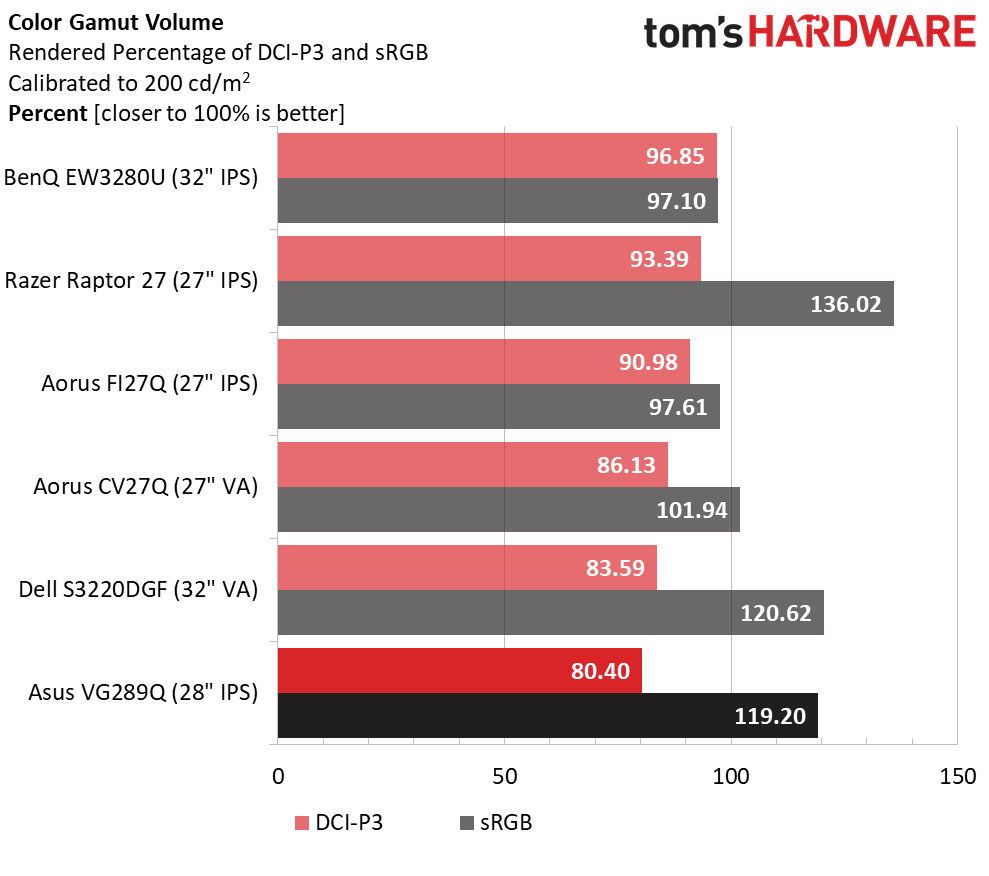
Many of the extended color monitors we’ve reviewed only offer the DCI-P3 gamut, so we’re comparing on that basis here. The VG289Q is in excellent company, as none of these displays have visible errors. The Asus boasts slightly better calibrated grayscale numbers and a top gamma result, so overall it has a slight edge on the others.
DCI-P3 gamut volume is a touch over 80%, making the VG289Q last place here. The main reason is because the green primary is 20% under-saturated. On the other hand, there is more than enough sRGB gamut volume, And if you employ a software look-up table, you can even use this monitor for color-critical work in the sRGB realm. But if your work or gaming requires DCI, the VG289Q comes up a little short.
MORE: Best Gaming Monitors
MORE: How We Test Monitors
MORE: All Monitor Content
Current page: Grayscale, Gamma and Color
Prev Page Brightness and Contrast Next Page HDR Performance
Christian Eberle is a Contributing Editor for Tom's Hardware US. He's a veteran reviewer of A/V equipment, specializing in monitors. Christian began his obsession with tech when he built his first PC in 1991, a 286 running DOS 3.0 at a blazing 12MHz. In 2006, he undertook training from the Imaging Science Foundation in video calibration and testing and thus started a passion for precise imaging that persists to this day. He is also a professional musician with a degree from the New England Conservatory as a classical bassoonist which he used to good effect as a performer with the West Point Army Band from 1987 to 2013. He enjoys watching movies and listening to high-end audio in his custom-built home theater and can be seen riding trails near his home on a race-ready ICE VTX recumbent trike. Christian enjoys the endless summer in Florida where he lives with his wife and Chihuahua and plays with orchestras around the state.
-
rsymartin27 One thing I hope dies soon is dp 1.2, I mean why even if they just use 1.4 we can get Gsync nd hdr both on same port. They should clearly mention that HDR will work only on hdmi in these monitors. Nd HDMI does not support G. Sync.Reply -
Phaaze88 Reply
Yeah, longevity is something most reviews don't cover. That's something for us as the customers to discover...Kridian said:The Amazon reviews of this ASUS TUF VG289Q are brutal! Buyer beware.
Speaking of longevity, those Enermax Liqtech coolers come to mind... -
Neuspeed Just buy a Pixio PX7 Prime for $399 and call it a day.. 2k IPS / 165 Hz / HDR / AMD free-sync / G-sync supported.Reply -
Zorkiz This is a zero buyer's regret purchase for me! I'm not a gamer, I just needed the best 4K IPS monitor for extended use at a sensible price. I took a gamble and bought the VG289Q for CAD/Office use based on its specs before there were any in depth reviews such as this one. Based on my subjective observations, I think this is an accurate review of what I have found to be an excellent and reliable 4K monitor for work/general purpose use, which is particularly surprising given the price. It looks like Asus have chosen a good IPS panel here. It's all in the review, but some points to emphasise:Reply
flicker-free backlight
good colour accuracy
even backlight brightness distribution
zero dead pixels
IPS panel gives very good viewing angles
blacks are good
three year warranty
superb stand - very solid and adujsts for height/tilt/rotation
not noticed any IPS "glow"
28" size
modest price
After about 500hours of operation there are no issues at all . BTW -if you look closely the Amazon reviews are actually for a mish-mash of similar Asus monitors. -
zainpk60 ReplyZorkiz said:This is a zero buyer's regret purchase for me! I'm not a gamer, I just needed the best 4K IPS monitor for extended use at a sensible price. I took a gamble and bought the VG289Q for CAD/Office use based on its specs before there were any in depth reviews such as this one. Based on my subjective observations, I think this is an accurate review of what I have found to be an excellent and reliable 4K monitor for work/general purpose use, which is particularly surprising given the price. It looks like Asus have chosen a good IPS panel here. It's all in the review, but some points to emphasise:
flicker-free backlight
good colour accuracy
even backlight brightness distribution
zero dead pixels
IPS panel gives very good viewing angles
blacks are good
three year warranty
superb stand - very solid and adujsts for height/tilt/rotation
not noticed any IPS "glow"
28" size
modest price
After about 500hours of operation there are no issues at all . BTW -if you look closely the Amazon reviews are actually for a mish-mash of similar Asus monitors.
I am also about to buy this and yeah most of the reviews on Amazon are for different styles. But I will still ask you this just as a suggestion. Should I proceed to buy it like I am coming from a 24 inch 1080p so is the 4k amazing on this monitor and how about the HDR. -
Zorkiz Hi Zainpk60,Reply
I went from a Dell IPS 24" to this one and yes, I think you should find the 4K amazing! I really can't say how good the HDR effect is as it's something I don't bother with as this is mainly my work monitor. IMHO the Tom's HARDWARE review seems pretty much spot-on so I think you could safely go with their take on HDR. I seem to recall that the maximum brightness, while plently bright enough for most purposes, is not quite enough to do HDR really well. -
zainpk60 ReplyZorkiz said:Hi Zainpk60,
I went from a Dell IPS 24" to this one and yes, I think you should find the 4K amazing! I really can't say how good the HDR effect is as it's something I don't bother with as this is mainly my work monitor. IMHO the Tom's HARDWARE review seems pretty much spot-on so I think you could safely go with their take on HDR. I seem to recall that the maximum brightness, while plently bright enough for most purposes, is not quite enough to do HDR really well.
So do you think its worth the investment of £350.